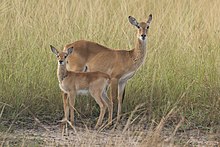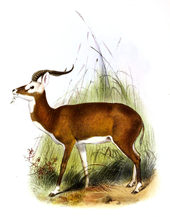
The term antelope refers to numerous extant or recently extinct species of the ruminant artiodactyl family Bovidae that are indigenous to most of Africa, India, the Middle East, Central Asia, and a small area of Eastern Europe. Antelopes do not form a monophyletic group, as some antelopes are more closely related to other bovid groups, like bovines, goats, and sheep, than to other antelopes.
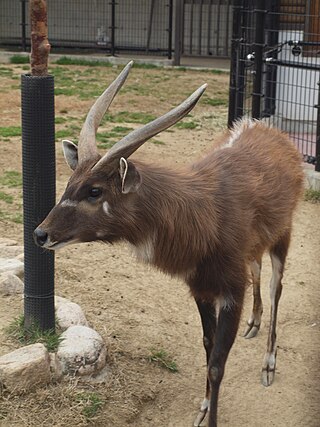
The sitatunga or marshbuck is a swamp-dwelling medium-sized antelope found throughout central Africa, centering on the Democratic Republic of the Congo, the Republic of the Congo, Cameroon, parts of Southern Sudan, Equatorial Guinea, Burundi, Ghana, Botswana, Rwanda, Zambia, Gabon, the Central African Republic, Tanzania, Uganda and Kenya. The sitatunga is mostly confined to swampy and marshy habitats. Here they occur in tall and dense vegetation as well as seasonal swamps, marshy clearings in forests, riparian thickets and mangrove swamps.

The greater kudu is a large woodland antelope, found throughout eastern and southern Africa. Despite occupying such widespread territory, they are sparsely populated in most areas due to declining habitat, deforestation, and poaching. The greater kudu is one of two species commonly known as kudu, the other being the lesser kudu, T. imberbis.

The common eland, also known as the southern eland or eland antelope, is a large-sized savannah and plains antelope found in East and Southern Africa. It is a species of the family Bovidae and genus Taurotragus. An adult male is around 1.6 m (5.2 ft) tall at the shoulder and can weigh up to 942 kg (2,077 lb) with a typical range of 500–600 kg (1,100–1,300 lb), 340–445 kg (750–981 lb) for females). It is the second-largest antelope in the world, being slightly smaller on average than the giant eland. It was scientifically described by Peter Simon Pallas in 1766.

The bovid subfamily Reduncinae or tribe Reduncini is composed of nine species of antelope, all of which dwell in marshes, floodplains, or other well-watered areas, including the waterbucks and reedbucks. These antelopes first appear in the fossil record 7.4 million years ago in Eurasia and 6.6 Mya in Africa.

The hirola, also called the Hunter's hartebeest or Hunter's antelope, is a critically endangered antelope species found as of now, only in Kenya along the border of Somalia. It was first described by the big game hunter and zoologist H.C.V. Hunter in 1888. It is the only living member of the genus Beatragus, though other species are known from the fossil record. The global hirola population is estimated at 300–500 animals and there are none in captivity. According to a document produced by the International Union for Conservation of Nature "the loss of the hirola would be the first extinction of a mammalian genus on mainland Africa in modern human history".

The common tsessebe or sassaby is the southern, nominate subspecies of Damaliscus lunatus, although some authorities have recognised it as an independent species. It is most closely related to the Bangweulu tsessebe, sometimes also seen as a separate species, less to the topi, korrigum, coastal topi and tiang subspecies of D. lunatus, and less to the bontebok in the same genus. Common tsessebe are found in Angola, Zambia, Namibia, Botswana, Zimbabwe, Eswatini, and South Africa.
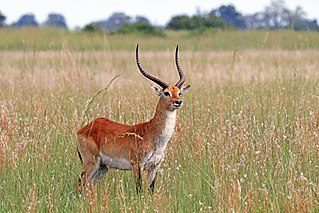
The lechwe, red lechwe, or southern lechwe is an antelope found in wetlands of south-central Africa.

The Nile lechwe or Mrs Gray's lechwe is an endangered species of antelope found in swamps and grasslands in South Sudan and Ethiopia.

The waterbuck is a large antelope found widely in sub-Saharan Africa. It is placed in the genus Kobus of the family Bovidae. It was first described by Irish naturalist William Ogilby in 1833. Its 13 subspecies are grouped under two varieties: the common or ellipsiprymnus waterbuck and the defassa waterbuck. The head-and-body length is typically between 177 and 235 cm and the typical height is between 120 and 136 cm. In this sexually dimorphic antelope, males are taller and heavier than females. Males reach roughly 127 cm (50 in) at the shoulder, while females reach 119 cm (47 in). Males typically weigh 198–262 kg (437–578 lb) and females 161–214 kg (355–472 lb). Their coat colour varies from brown to grey. The long, spiral horns, present only on males, curve backward, then forward, and are 55–99 cm (22–39 in) long.
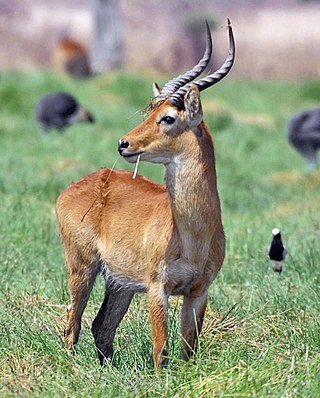
The puku is a medium-sized antelope found in wet grasslands in southern Democratic Republic of Congo, Namibia, Tanzania, Zambia and more concentrated in the Okavango Delta in Botswana. Nearly one-third of all puku are found in protected areas, zoos, and national parks due to their diminishing habitat.

The bohor reedbuck is an antelope native to central Africa. The animal is placed under the genus Redunca and in the family Bovidae. It was first described by German zoologist and botanist Peter Simon Pallas in 1767. The bohor reedbuck has five subspecies. The head-and-body length of this medium-sized antelope is typically between 100–135 cm (39–53 in). Males reach approximately 75–89 cm (30–35 in) at the shoulder, while females reach 69–76 cm (27–30 in). Males typically weigh 43–65 kg (95–143 lb) and females 35–45 kg (77–99 lb). This sturdily built antelope has a yellow to grayish brown coat. Only the males possess horns which measure about 25–35 cm (9.8–13.8 in) long.
Gambella National Park, also spelled Gambela National Park, is a 5,016 km2 (1,937 sq mi) large national park in Ethiopia. It is the nation's largest national park and is located several hundred kilometers from Addis Ababa. It was established in 1974, but is not fully protected and has not been effectively managed for much of its history.

The blue wildebeest, also called the common wildebeest, white-bearded gnu or brindled gnu, is a large antelope and one of the two species of wildebeest. It is placed in the genus Connochaetes and family Bovidae, and has a close taxonomic relationship with the black wildebeest. The blue wildebeest is known to have five subspecies. This broad-shouldered antelope has a muscular, front-heavy appearance, with a distinctive, robust muzzle. Young blue wildebeest are born tawny brown, and begin to take on their adult coloration at the age of 2 months. The adults' hues range from a deep slate or bluish-gray to light gray or even grayish-brown. Both sexes possess a pair of large curved horns.
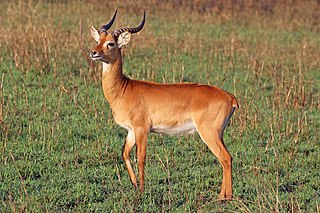
The Ugandan kob is a subspecies of the kob, a type of antelope. It is found in sub-Saharan Africa in South Sudan, Uganda and the Democratic Republic of the Congo. The Ugandan kob is normally reddish-brown, differentiating it from other kob subspecies.

Damaliscus lunatus is a large African antelope of the genus Damaliscus and subfamily Alcelaphinae in the family Bovidae, with a number of recognised geographic subspecies. Some authorities have split the different populations of the species into different species, although this is seen as controversial. Common names include topi, sassaby, tiang and tsessebe.

Grant's gazelle is a relatively large species of gazelle antelope, distributed from northern Tanzania to South Sudan and Ethiopia, and from the Kenyan coast to Lake Victoria. Its Swahili name is swala granti. It was named for a 19th-century British explorer, James Grant.

The Mongalla gazelle is a species of gazelle found in the floodplain and savanna of South Sudan. It was first described by British zoologist Walter Rothschild in 1903. The taxonomic status of the Mongalla gazelle is widely disputed. While some authorities consider it a full-fledged monotypic species in the genus Eudorcas, it is often considered a subspecies of Thomson's gazelle, while other authorities regard it as subspecies of the red-fronted gazelle.
Boma National Park is a protected area in eastern South Sudan near the Ethiopian border. It was established in 1977 and covers 22,800 km2 (8,800 sq mi) of grasslands and floodplains.
The Cape lechwe or Venter's lechwe is an extinct species similar to the red lechwe, Kobus leche. It was described by Robert Broom from a frontlet and horn core from Haagenstad, which Broom believed to be an intermediate form between lechwe and waterbuck. However others have failed to find justification for separating the species from Kobus leche.

